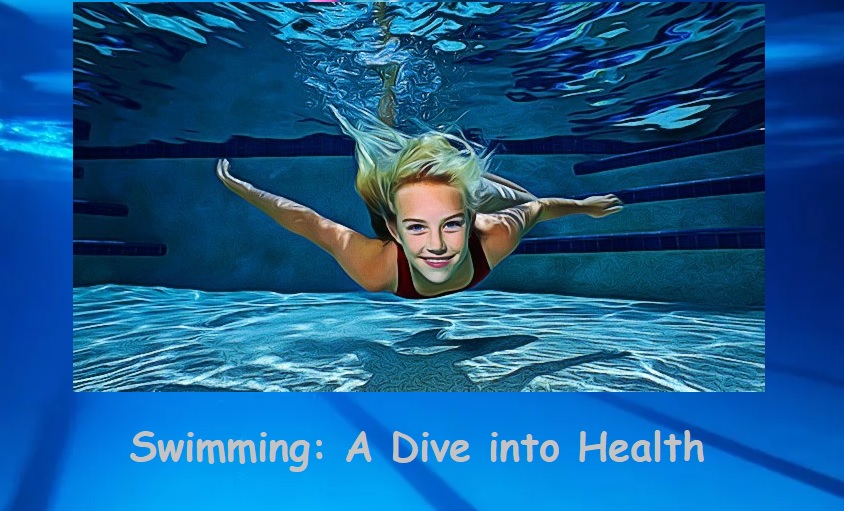Swimming is not only a refreshing leisure activity but also a fantastic way to boost your overall health. Here are some reasons why you should consider diving into the pool:
Full-Body Workout: Unlike many other forms of exercise, swimming engages almost all of the body’s muscles. From your arms and legs to your core, swimming provides a comprehensive workout, helping to build strength and endurance.
Low-Impact Exercise: For those with joint pain or injuries, swimming offers a low-impact alternative to activities like running or weightlifting. The buoyancy of water reduces stress on the joints while still providing an effective workout.
Cardiovascular Health: Swimming is an excellent cardiovascular exercise, working the heart and lungs to improve overall fitness and endurance. Regular swimming can help reduce the risk of heart disease, stroke, and high blood pressure.
Weight Management: Swimming burns a significant number of calories, making it an effective way to manage weight and body composition. It also increases metabolism, promoting fat loss and muscle toning.
Improved Flexibility and Mobility: The range of motion required for swimming strokes promotes flexibility and mobility in the joints and muscles. Over time, this can lead to increased agility and reduced risk of injury.
Stress Relief: Swimming is known for its calming effect on the mind. The rhythmic motion and focus on breathing can help reduce stress and anxiety, promoting mental well-being.
Social and Recreational Benefits: Whether swimming laps alone or participating in a group class, swimming can be a social activity that enhances mental and emotional health through interaction with others.
In conclusion, swimming offers a multitude of health benefits, making it a valuable addition to any fitness routine. So, grab your swimsuit and dive in for a healthier, happier you!
Benefits of Swimming for Fitness
Swimming offers numerous health benefits, including:
- Cardiovascular Health: Swimming is a great aerobic exercise that gets your heart pumping and improves circulation, leading to a healthier cardiovascular system and reduced risk of heart disease.
- Full-Body Workout: It engages multiple muscle groups simultaneously, providing a comprehensive workout for your arms, legs, core, and back. This helps build strength, endurance, and muscle tone.
- Low-Impact Exercise: Unlike high-impact activities like running, swimming is gentle on the joints, making it ideal for people with arthritis, joint pain, or mobility issues. It reduces the risk of injury while still providing an effective workout.
- Weight Management: Swimming burns a significant number of calories, making it an excellent option for weight management and fat loss. It boosts metabolism and helps maintain a healthy body composition.
- Improved Flexibility and Range of Motion: Swimming involves stretching and elongating the muscles, which can improve flexibility and range of motion in the joints. This can enhance athletic performance and reduce the risk of injury.
- Stress Relief: The rhythmic movement and focus on breathing in swimming have a calming effect on the mind, reducing stress and anxiety levels. It promotes relaxation and overall mental well-being.
- Respiratory Health: Swimming requires controlled breathing techniques, which can strengthen the respiratory muscles and improve lung capacity over time. This can be beneficial for individuals with asthma or other respiratory conditions.
- Better Sleep: Regular exercise, such as swimming, has been shown to improve sleep quality and duration. It helps regulate sleep patterns, promotes relaxation, and reduces symptoms of insomnia.
- Social Interaction: Swimming can be a social activity when done in groups or classes, providing opportunities for interaction and camaraderie. This social support can contribute to improved mental health and overall well-being.
- Longevity: Research has shown that regular swimming is associated with a longer lifespan and better quality of life in older adults. It promotes healthy aging by maintaining physical fitness, mobility, and cognitive function.
Overall, swimming is a versatile and enjoyable exercise that offers a wide range of health benefits for people of all ages and fitness levels. Whether you’re looking to improve your cardiovascular health, build strength and endurance, or simply relax and unwind, diving into the pool can be a fantastic way to boost your overall well-being.
How to Start Swimming for Fitness
Starting a swimming routine can be both exciting and rewarding. Here are some steps to help you get started:
Set Your Goals: Determine what you want to achieve with swimming. Whether it’s improving fitness, learning a new skill, or training for a specific event, having clear goals will keep you motivated.
Choose the Right Gear: Invest in a comfortable swimsuit that allows for easy movement. Goggles will protect your eyes from chlorine and help you see underwater. If you’re a beginner, consider using a swim cap to keep your hair out of your face.
Find a Suitable Pool: Look for a nearby swimming pool that fits your schedule and budget. Consider factors like distance from your home or workplace, operating hours, cleanliness, and availability of amenities such as showers and changing rooms.
Learn the Basics: If you’re new to swimming or haven’t swum in a while, consider taking lessons from a certified swim instructor. They can teach you proper techniques for various strokes, breathing patterns, and safety skills like treading water and floating.
Start Slowly: Don’t push yourself too hard at the beginning. Start with short sessions of 15-20 minutes and gradually increase the duration as your stamina improves. Focus on maintaining good form and breathing rhythm.
Mix It Up: Variety is key to staying engaged and avoiding boredom. Experiment with different strokes, such as freestyle, breaststroke, backstroke, and butterfly. You can also incorporate drills, kickboard exercises, and interval training to keep your workouts challenging and fun.
Stay Consistent: Consistency is essential for progress in swimming. Aim to swim at least 2-3 times per week to maintain momentum and see improvements in your skills and fitness level.
Listen to Your Body: Pay attention to how your body feels during and after swimming. If you experience any pain or discomfort, take a break and consult a medical professional if necessary. It’s important to prioritize safety and avoid overexertion.
Track Your Progress: Keep a log of your swimming sessions, noting the distance covered, time taken, and any improvements in technique or endurance. Tracking your progress can help you stay motivated and celebrate your achievements along the way.
Enjoy the Experience: Above all, remember to enjoy the experience of swimming. Whether you’re gliding through the water or challenging yourself with a new goal, swimming can be a rewarding and fulfilling activity for both body and mind.
By following these steps and staying committed to your swimming routine, you’ll be well on your way to making a splash in the pool!
What You Need to Swim for Exercise
When swimming for exercise, there are a few essential items you’ll need to ensure a safe and effective workout:
Swimsuit: Choose a comfortable and well-fitting swimsuit that allows for freedom of movement. Look for materials designed for swimming, such as nylon or polyester, which provide durability and quick drying.
Goggles: Protect your eyes from chlorine and other irritants in the water by wearing swim goggles. Look for goggles with adjustable straps and a snug fit to prevent leakage.
Swim Cap (optional): While not essential, a swim cap can help keep your hair out of your face and reduce drag in the water, especially for those with long hair.
Towel: Bring a large, absorbent towel to dry off after your swim. Microfiber towels are lightweight and quick-drying, making them ideal for the pool.
Flip-flops or Sandals: Wear flip-flops or sandals to protect your feet from hot surfaces, rough pool decks, and potential fungal infections in communal areas like locker rooms.
Water Bottle: Stay hydrated during your swim session by bringing a water bottle to the poolside. Choose a reusable bottle that you can easily refill to minimize plastic waste.
Swim Accessories (optional): Depending on your preferences and skill level, you may also consider additional swim accessories such as:
Kickboard: Helps improve leg strength and technique by isolating the lower body during drills.
Pull Buoy: Floats between your legs to focus on upper body strength and stroke technique.
Fins: Increase propulsion and speed in the water, ideal for swim training and building leg strength.
Hand Paddles: Enhance arm and shoulder muscles, improve stroke technique, and increase resistance in the water.
Sunscreen (if swimming outdoors): If swimming outdoors, don’t forget to apply waterproof sunscreen to protect your skin from harmful UV rays. Choose a broad-spectrum sunscreen with SPF 30 or higher and reapply as needed.
By having these essentials on hand, you’ll be well-equipped to enjoy a safe, comfortable, and productive swimming workout. Adjust your gear based on your individual needs and preferences to make the most of your swimming experience.
Where to Swim for Fitness
There are several options for swimming for fitness:
Public Swimming Pools: Many communities have public swimming pools that offer lap lanes and open swim times for fitness swimming. These pools often have amenities such as showers, changing rooms, and sometimes even aquatic fitness classes.
Private Gyms or Health Clubs: Gyms and health clubs often have indoor swimming pools available to their members. These facilities may offer lap swimming, water aerobics classes, and other aquatic fitness programs.
University or College Facilities: Some universities and colleges have swimming pools that are open to the public or available for use by students and faculty. These pools may offer discounted rates for community members or alumni.
Recreational Centers: Recreational centers and community centers may have swimming pools that are open to the public for fitness swimming. These facilities often offer affordable rates and may have programs for swimmers of all ages and abilities.
Outdoor Pools or Beaches: During the warmer months, outdoor pools and beaches provide opportunities for fitness swimming in natural settings. Just be sure to check for safety precautions and water conditions before swimming outdoors.
Municipal Parks and Recreation Programs: Some cities and towns offer aquatic fitness programs through their parks and recreation departments. These programs may include swim lessons, water aerobics, and other fitness classes held at local pools.
Swim Clubs or Masters Swimming Groups: For more serious swimmers, joining a swim club or Masters swimming group can provide access to structured workouts, coaching, and camaraderie with other swimmers who share your fitness goals.
When choosing a location for swimming for fitness, consider factors such as cost, convenience, facility amenities, and the type of swimming environment you prefer (e.g., indoor vs. outdoor, pool size, water temperature). With the right resources and a bit of research, you can find a swimming venue that suits your needs and helps you achieve your fitness goals.
Swimming Workout for Beginners
For beginners, it’s important to start slowly and gradually build up your swimming endurance and technique. Here are some simple swim workouts to help you get started:
Warm-Up (5-10 minutes):
Start with a few laps of easy swimming, focusing on getting comfortable in the water and warming up your muscles.
Practice basic strokes such as freestyle (front crawl) and backstroke to loosen up your arms and legs.
Drills for Technique (10-15 minutes):
Kickboard Kicks: Hold onto a kickboard with your arms extended and kick your legs behind you. Focus on keeping your body in a horizontal position and kicking from your hips.
Arm Pulls with Pull Buoy: Place a pull buoy between your legs to float and focus on your upper body. Practice pulling with your arms, keeping them straight and pulling through the water with your palms facing backward.
Main Set (15-20 minutes):
Swim Intervals: Alternate between swimming and resting to build endurance and cardiovascular fitness.
Example: Swim one lap (25 meters/yards), then rest for 30 seconds. Repeat for a total of 10 laps.
Mix Up Strokes: Alternate between different strokes such as freestyle, backstroke, breaststroke, and elementary backstroke to work different muscle groups and improve overall swimming skills.
Cool Down (5-10 minutes):
Swim Easy: Finish your workout with a few laps of easy swimming to cool down and relax your muscles.
Stretch: Spend some time stretching your arms, shoulders, back, and legs to improve flexibility and prevent muscle soreness.
Breathing Practice:
Practice Breathing Techniques: Spend some time practicing rhythmic breathing while swimming. Exhale slowly underwater and inhale quickly when you turn your head to the side to breathe.
Use a Kickboard: Hold onto a kickboard and practice breathing while kicking gently. This will help you focus on your breathing without worrying about coordinating your arm strokes.
Safety Tips:
Always swim in a supervised area with a lifeguard on duty, especially if you’re a beginner.
Start with shorter swim sessions and gradually increase the duration and intensity as you build strength and endurance.
Listen to your body and take breaks as needed. Don’t push yourself too hard, especially if you’re feeling tired or out of breath.
Remember to stay hydrated and have fun while swimming! As you become more comfortable in the water and improve your skills, you can gradually increase the intensity and complexity of your workouts.
In the Nutshell
“In conclusion, swimming is a highly effective exercise for improving both health and fitness. Overall, swimming offers a fun, challenging, and rewarding way to improve your overall health and fitness. By making swimming a regular part of your routine and setting achievable goals, you can reap the many benefits that swimming has to offer for a healthier, happier lifestyle.”
“Swimming: A Dive into Health” illuminates the multifaceted benefits of swimming as a holistic approach to enhancing physical and mental well-being.
Through its comprehensive examination, it becomes evident that swimming offers unparalleled advantages, ranging from cardiovascular improvement to stress reduction.
As a low-impact exercise, it accommodates individuals of all ages and fitness levels, making it accessible and inclusive.
Furthermore, the therapeutic properties of water, combined with the rhythmic movements of swimming, foster a sense of tranquility and mindfulness. In conclusion, swimming emerges not only as an enjoyable recreational activity but also as a powerful tool for promoting overall health and vitality.
Embracing swimming as a regular part of one’s lifestyle can lead to profound and lasting improvements in both physical and mental health, ultimately enabling individuals to dive deeper into a life of wellness.







三人組ポルノ .TqBppUxi9oP
Hi there, just became aware of your blog through
Google, and found that it’s truly informative. I’m going to watch
out for brussels. I’ll appreciate if you continue this in future.
A lot of people will be benefited from your writing. Cheers!
Escape rooms hub
Very interesting points you have mentioned, thanks
for posting.!
You have a knack for explaining things clearly and concisely, much appreciated.
Your writing is both eloquent and relatable.
Pretty! This has been an extremely wonderful article. Thank you for supplying these details.